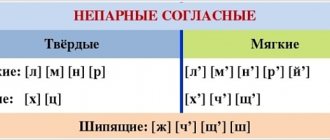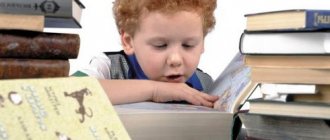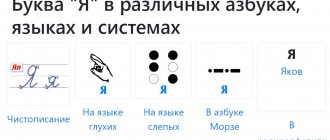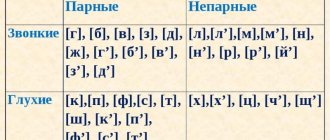Summary of a writing lesson for 3rd grade students of a correctional school of the VIII type
Lesson summary on writing and speech development in the 3rd grade of a correctional school of the VIII type. Topic: Sounds and letters. Hard and soft consonants
This summary will be useful to primary school teachers. During the lesson, students become familiar with soft and hard consonants.
Topic: SOUNDS AND LETTERS.
HARD AND SOFT CONSONANTS. Goal:
to clarify and concretize students’ understanding of the difference between consonants in hardness and softness.
Lesson objectives.
Educational: develop the ability to distinguish between soft and hard consonant sounds and pronounce them correctly in words. Correctional and developmental: develop the ability to analyze changes occurring in nature, enrich vocabulary, develop spelling vigilance. Educational: to instill in children interest, love, and respect for nature; promote the development of observation.
Lesson progress
I. Organizational moment.
Game "Don't break the chain."
The teacher says a word. The student must choose his word so that it begins with the sound that ends the word named by the teacher: lemon —— rhinoceros —— mountain —— bus —— cheese, row —— sofa —— threads —— needle —— watermelon, umbrella — — tiger —— pen —— orange ——» …. II.
Lesson topic message. - Read the words.
Name words in which all consonants are soft. A day, a student, a car, tears, a tractor. — How is the softness of consonants indicated in writing? — What ways do you know to indicate the softness of consonants in writing? — Today we are starting to study a new section called “Hard and soft consonants.” You will learn to distinguish consonants by hardness and softness. III.
A minute of penmanship (correction of optical dysgraphia).
Working with individual cards. Read the words correctly and write them in your notebook. IV.
Learning new material. Read the entry on the board: People began to draw a long time ago.
They drew animals. —What is said in the text? — How many sentences have been written down? How did you find out? - Write it down, dictating to yourself syllable by syllable. - Say the consonants in the first word; in the last word. What can you say about these consonant sounds? - What letters indicate soft consonants in writing? - Underline these letters. The letters i, yu, i, ё, e are vowel letters. Soft consonants make friends with them in writing. Physical school The teacher, throwing a ball, pronounces a word with a hard consonant sound (“with a hard connection”). The student who catches the ball pronounces a similar word with a “soft connection”: rad - row, small - crumpled, bow - hatch, nose - carried, cart - carried, rad - row, ox - led, ships - here, mouse - bear. Working with the textbook. Page 77 ex. 3. Task: Form syllables and write them down. Emphasize the hard consonants. V. Consolidation of knowledge.
Working with the textbook.
p. 78 ex. 4. Task: Name the pictures in pairs, write down their names. Emphasize the soft consonants. — How did you determine which consonants are soft? — Which letters indicate the softness of a consonant? - Which ones - for the hardness of a consonant? VI.
Lesson summary. — What two groups can all consonants be divided into?
- Name a syllable with a soft consonant. Write it down. - Name a syllable with a hard consonant. Write it down. — What vowel letters indicate the softness of consonants in writing? VII.
Homework . p. 77 ex. 2 (according to the textbook by A.K. Aksenova, E.V. Yakubovskaya Russian language grade 3)
We recommend watching:
Lesson summary of Kuban studies, grade 3 Development of the abilities of a child with disabilities in the process of artistic creativity Holiday scenario. Festival “Learning Without Limits”. Opening of the festival A set of exercises for preschoolers to develop ideas about color, shape and size
Similar articles:
Lesson - generalization on the topic “Noun”
Lesson notes on the Russian language, grade 3
Summary of a Russian language lesson in 3rd grade on the topic: Suffixes
Summary of an integrated lesson in 3rd grade on world knowledge, Russian language and mathematics
Lesson summary in 3rd grade based on the story “Shark” by L. N. Tolstoy
Summary of a Russian language lesson in 1st grade
Lesson topic: “Indicating the softness of consonant sounds with vowel letters”
Class : 1st grade Lesson duration: 40 minutes Purpose: to systematize knowledge about the letters indicating the softness of consonants in writing. Objectives: 1. Improve the ability to correlate pronunciation and spelling, perform a sound-letter analysis of a word. 2. Develop spelling vigilance, self-control skills, logical actions, classification, analysis, synthesis. 3. Cultivate interest in language, the desire to speak and write correctly and accurately in their native language. Expected results: Personal results:
awareness of the teaching;
meaning making; moral and ethical orientation, including assessment of the acquired content, ensuring personal social choice. Meta-subject results: Cognitive:
developing the skills to independently identify and formulate a cognitive goal;
construct a speech utterance orally; compare and classify the sound composition of a word according to given and independently selected criteria; use sign-symbolic means to create a model of a word; search and highlight the necessary information from the listened text; communicative: the ability to consciously construct a speech statement; argue your point of view; adequately evaluate one’s own behavior while solving a joint learning task; negotiate and come to a common decision in joint activities; regulatory: setting an educational task; accepting and maintaining a learning task; highlighting and awareness by students of what has been learned previously and what remains to be done; assessing the results of your activities and the activities of your partner. Subject results:
the ability to indicate the softness of consonant sounds with vowels and a soft sign.
Lesson type: lessons on skill development and reflection. Teaching methods: visual, practical, partially search-based. Forms of work: frontal, paired, individual Technologies used: activity approach technology, elements of research teaching methods. Equipment : computer, projector, screen, presentation, textbook T.G.
Ramzaeva, notebook Lesson progress.
Organizational moment Motivation - Let's smile at each other, thereby wishing each other success in learning. Now let’s greet our guests with a smile. I think that the lesson will bring us all the joy of communicating with each other. You will learn a lot and learn a lot. And for this, what should we be like throughout the lesson? We are smart, we are friendly, we are attentive, we are diligent. In the first “D” we learn. We will succeed! -Sit down quietly at your desks. In order to write beautifully you need 3 points of support. Remind yourself. They placed their feet on the floor, their back touched the back of the chair, and checked the distance to the desk with their palm. - Well done. Regulatory uud. Providing students with organization of their educational activities. An emotionally positive attitude towards the lesson, creating a situation of success and trust. Updating knowledge. -A minute of penmanship. And before we start writing, let’s prepare our fingers and stretch them a little. Exercise “Wasp” Exercise “Helicopter” - Our fingers are ready to write. -Opened the notebooks, put them on the corner, took the pens. We hold the handle with 3 fingers. It lies between the middle and thumb, and the index finger presses it on top. -Write down the number. -There are elements of letters on the board. -How many are there? -List what these elements are? -Which of them can be used to form letters? -Let's write a whole line of capital and lowercase letters Ll -Come up with syllables in which the sound [l] sounds hard. Why? -Come up with syllables in which the sound [l] sounds soft. Why? Cognitive education Updating basic knowledge Setting the topic and goals of the lesson. The teacher reads the fairy tale “The Braggart.” A famous magician lives in the land of Grammar. As soon as he approaches a word, it becomes completely unrecognizable: the word EL turned into the word FIR, and the tin CAN became a warm BATH. Who is this magician? A soft sign boasted: I am, they say, the most magical. But some residents of the country of Grammar began to laugh: “We also know how to show tricks. Look: LUK became LUK, was MAL became MYAL, RAD turned into the word ROW, WHO became VEZ, WAS became BIL. - Who put the braggart in his place? - Why did the consonants become soft even without it? - What do you think is the topic of today's lesson? -Let's open the textbooks on page 50 and read the topic of the lesson. - Let's set the goals of the lesson. -Let's determine our position on our ladder of knowledge. Are we already familiar with these letters? Where did we meet them? Which lesson? What command are they executing? What level will we put ourselves on? Cognitive sound Analysis of objects in order to identify features that characterize a given sound. Independent formulation of a cognitive goal (task) Extracting the necessary information from a listened riddle text. Communicative activities Collaboration with the teacher and children, expressing one’s opinion, consciously constructing a speech utterance Regulatory actions Identification and awareness by students of what has been learned previously and what remains to be done. Discovery of new knowledge - We work with the textbook on page 51 with exercise 88. Since we have guests today, so that they can also see, I put this exercise on the board. We read the task Read: Lara, Lenya, Lilya, Petya, Roma. -Let's compare these words. What do they have in common? -What is the difference between these words? -What two groups can they be divided into? Why? Lara, Roma Lenya, Lilya, Petya. - Say consonants. Give them a description. What letters indicate the hardness of consonant sounds in words? -Let us emphasize the hard consonants with one line. -What other vowels do you know that indicate the hardness of consonant sounds? Formulate a rule: vowels…..indicate the hardness of the preceding consonant -Look at the 2 groups of words. -Say consonant sounds. Give them a description. What letters indicate the softness of consonant sounds? -We emphasize soft consonants with two strokes. -Which letter is missing? Formulate a rule: vowels…..indicate the softness of the preceding consonant. Cognitive functions are the comparison and classification of the sound composition of a word according to independently selected criteria. Identification of essential features Communicative skills Collaboration with children, expressing their opinions, agree and come to a common decision in joint activities Communicative skills argue their point of view Cognitive skills Use of sign-symbolic means to create a model of a word Primary consolidation with commenting - Write down the names, not forgetting to underline hard and soft consonants. (children work in notebooks) -Which group would you write down the name Dasha in? Why? -Which group would you put the name Mitya in? Why? -Which group would you classify the name Marina in? Why? Communicative actions Ability to consciously construct a speech statement Independent work with testing against a standard. -How can you call these words in one word? Who is this? - Write down the words GUYS with sounds - Let's write down this word. R... guys -What letter will we write after the letter r? Where can we find out how to spell a given word? - Come up with a sentence with this word. Let's write it down. The guys are studying at school. -Underline the main parts of the sentence -Yourself, underline hard consonants with one line, soft consonants with two. Cognitive skills Use of sign-symbolic means to create a model of a word Communicative actions Ability to consciously construct a speech utterance Inclusion in the knowledge system Let's play with you too. Game “BE CAREFUL” If the first consonant sound is hard, clap your hands, if soft, stomp your feet. Sleeve, backpack, hare, finch, rice, lynx, sprinkle, sieve, ticket, ballet. -Work in a notebook p. 32 exercise. 41. -Exchange notebooks. Check each other. Rate each other. Cognitive udd Compare and classify the sound composition of a word according to specified criteria Regulatory udd Evaluate the results of the partner’s activities Reflection. - Well, our lesson has come to an end. -Let's go back to our ladder of knowledge. — Have we solved all the assigned tasks, what do you think? -Now what level can we put ourselves on? - What letters indicate the softness of a consonant? hardness? - Continue one of the sentences: -I liked it... -I didn’t like it... -I learned... -I learned... -I didn’t succeed... Personal UUD. Sense-making, i.e. The student wonders what the lesson taught? Moral and ethical orientation, including assessment of the acquired content that ensures personal social choice Regulatory actions Identification and awareness by students of what has been learned in the lesson, awareness of the quality and level of assimilation
We recommend watching:
Entertaining Russian language Test work in the Russian language, 1st grade Notes of a lesson in the Russian language in the post-primary period, 1st grade Notes of a lesson in the Russian language in 1st grade according to the Federal State Educational Standard
Similar articles:
Summary of the final extracurricular lesson in the Russian language in 1st grade
Lesson notes on the Russian language, 1st grade. Text. School of Russia
Lesson notes on the Russian language, 1st grade. The role of words in speech. School of Russia
Lesson notes on the Russian language, 1st grade. Polite words. School of Russia
Lesson notes on the Russian language, 1st grade. Single and polysemous words. School of Russia
Selective dictations on the topic: Indication of softness and hardness of consonants in writing.
Dictation 1. Task: Write down words that have soft consonants in one column, and the rest in another.
Flax, forehead, nose, but, carried, sat down, sleep, crowbar, ice, crumpled, forest, small, cancer, scream, hook, poppy, cheese, rice, climbed, people, lamp, puddle, animals, keys, straw, shore, hand.
Dictation 2.
Assignment: Listen to the poem and riddles.
Write down as many words as possible with soft consonants. Poem
The white birch tree under my window is covered with snow, like silver. And the birch tree stands in sleepy silence. And snowflakes burn in golden fire. On the fluffy branches, like a snowy border, brushes blossomed like a white fringe. And the dawn, lazily going around, sprinkles the branches with white silver. (S. Yesenin)
Puzzles
1) Whoever goes to the owner, She lets him know. (Dog) 2) Behind the fishing line, behind the fishing line, a mountain of sand is boiling. (Anthill) 3) It shines, but does not warm. (Moon) 4) It’s white in winter, and gray in summer. (Hare)









